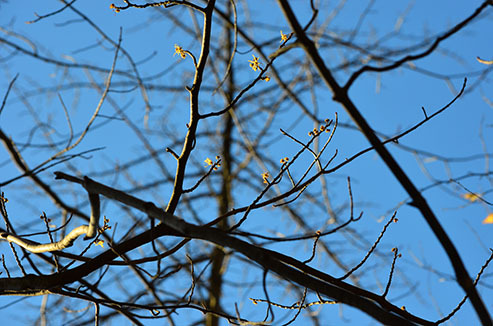Witch Hazel : Making Witch Hazel Extract

Twigs of witch hazel tree in late fall: Colchester, VT (Hayes, 2014)
Traditionally, witch hazel extract was made by boiling its stems and extracting the liquid. Commercial production of witch hazel extract began in the early to mid 1800s. In the distillery, segments of the tree are distilled in stainless steel vats, where they are steamed for around 36 hours. A “vaporized essence” comes from witch hazel’s cambium layer, below its bark. The segments are scrubbed, reheated to vapor, condensed, and then filtered. Traditionally produced extract had a brown color because of the flavonoids and tannins found in witch hazel. Commercial witch hazel is generally clear, containing 14% alcohol and 86% distilled witch hazel. In 1946 alone, 1,075,264 gallons of witch hazel extract were manufactured.
To collect wood for distillation, trees were cut locally, in the forests of New England. Now, most wood comes from part of Connecticut. The collection process begins around October. Some may just collect branches from a witch hazel tree, or in some cases, they harvest the tree almost in its entirely, leaving only a stump behind. Witch hazel regrows from stumps very well, however, meaning a new tree will regrow in just a few years. This allows collectors to continue the harvesting within local regions.
